INTRODUCTION
Network attached storage devices (NAS servers as we like to call them) have always offered a cost-effective solution not only for both local and remote file sharing but also for a plethora of functions including web hosting, system backup, media playback and sharing (video, audio and pictures), network video recording (surveillance), file download, web browsing and more. Even though however due to the large number of possible functions network attached storage devices are able to cover every segment of the market (from regular consumers to enthusiasts and professionals) no manufacturer has ever tried to aim them towards gamers, at least until now. ASUSTOR is the very first to do that and today we'll be thoroughly testing their brand new AS5304T model (also referred to as Nimbustor 4).
Founded in 2011, ASUSTOR Inc. was established via direct investment from ASUSTeK Computer Inc. The ASUSTOR brand name was created as a portmanteau of “ASUS” and “Storage”. ASUSTOR is a leading innovator and provider of private cloud storage (network attached storage) and video surveillance (network video recorder) solutions, also specializing in the development and integration of related firmware, hardware and applications. We are devoted to providing the world with an unparalleled user experience and the most complete set of network storage solutions possible.
Compared to older models ASUSTOR has given two new things to the Nimbustor line of NAS (2/4 SATA III bay models - Single/JBOD/RAID 0/RAID 1/RAID 5/RAID 6/RAID 10), design (diamond cut black plastic exterior - thanks to the red "touches" it reminds us of AMD and ASUS ROG) and dual 2.5GbE connectivity (based on Realtek RTL8125 chips - backwards compatible with 10/100/1000Mbps) which via link-aggregation (when supported by your router/switch) can achieve speeds of up to 5GbE (500MB/s+). Under the hood of the AS5304T we find the Intel Celeron J4105 quad-core Processor (UHD Graphics 600/4MB Cache/10W TDP/burst speed up to 2.50GHz) together with 4GB SO-DIMM DDR4-2400 RAM (expandable to 8GB) and a 4GB eMMC flash memory module (MLC/JEDEC eMMC 5.1 standard). As for available connectors the AS5304T Nimbustor 4 is outfitted with 3 USB 3.2 Gen 1 ports, 2 RJ45 2.5G Ethernet ports (with support for link aggregation) and a single HDMI 2.0a output (supports 4k HDR playback). Also just like with previous models ASUSTOR covers the brand new Nimbustor line of NAS with a 3-year limited warranty.
SPECIFICATIONS AND FEATURES

PACKAGING AND CONTENTS
As with previous models by ASUSTOR at the front of the box we see a product picture and its main specifications and features.
On the left side of the box we find a sticker with two product pictures (used to showcase the available connectors, LEDs and buttons), the product hardware specifications and the contents of the bundle.
4 drawings located on the right side represent some of the available features.
The rear of the box is black and just has the company logo on it.
Once you open up the box you will see 5 barcodes that point to the ASUSTOR website and social media pages.
The NAS is wrapped inside a plastic bag and placed between two foam spacers while the rest of the bundle is placed inside a cardboard box.
Along with the AS5304T you are also getting a 90W power adapter and its power cord, two RJ45 ethernet cables, quick installation guide and a plastic bag with 2.5" drive mounting screws.
THE AS5304T EXTERIOR
The 2.2Kg heavy black plastic housing of the AS5304T measures 230mm in length, 174mm in width and 170mm in height.


Exactly like with previous models the activity LEDs for the system health, LAN status, USB ports and the mounted drives are located on the left side of the fascia right beneath the power button and above the one touch backup button and one of the USB 3.2 Gen 1 ports.
The company logo is located on the top right of the fascia.
As with previous ASUSTOR models the fascia is made out of plastic and is actually a removable cover (magnets placed on all 4 corners).


 Once removed we see the 4 drive trays all of which are made out of plastic and can be fitted with either 3.5" or 2.5" drives (tool-less installation for 3.5" drives).
Once removed we see the 4 drive trays all of which are made out of plastic and can be fitted with either 3.5" or 2.5" drives (tool-less installation for 3.5" drives).



Turning the device around we see a large 120mm exhaust fan alongside two USB 3.2 Gen 1 ports, HDMI 2.0a output, 2.5G Ethernet ports, reset button and the DC in.


The AS5304T sits on 4 rubber feet and its housing opens up the same way as did previous models.
THE AS5304T INTERIOR
As expected, although the exterior of the AS5304T is made out of plastic the interior frame is made out of aluminum.
The quad-core intel Celeron J4105 CPU is located beneath a large aluminum heatspreader.




Inside the unit we also find the ITE IT8625E controller (used for system monitoring and fan control), two SO-DIMM slots (one is already used by a 4GB DDR4-2400 module by TLA), two RTL8125 2.5G chips and the 4GB eMMC flash memory module by Kingston.
With 4 of our Seagate IronWolf 12TB SATA III drives mounted we're ready to start our tests.
SETUP
Even though you can also start the setup procedure via your smartphone (connected to the local network of course) as usual we'll be using the ASUSTOR Control Center software which locates the NAS on your local network.
Once you click on the NAS a web browser window will open to start the setup procedure (an HDD needs to be mounted in the NAS).
The installation wizard will ask you to either update the firmware of the NAS automatically from the internet or manually (you will need to download it first) as seen above.
Next step will be to format the mounted drive, create partitions, install the firmware and restart the NAS.
After that you can choose between the fast 1-click setup and the custom setup (we always follow the lengthier custom route).




Via the custom route you will need to set the server name (if you don't like/want the default one), server password, time zone, network options and configure the drives (single/RAID/JBOD modes) in order to proceed.
If you decide to format the drive or drives using the Btrfs file system you can use the snapshots feature which effectively backups all the data in your NAS (for our performance tests we used EXT4).



At the end of the setup procedure you will be asked to register the NAS and choose the services you'd like installed (for Home/Personal or Business use - again we used both for this review).
ADM 3.4.2.R932 PART 1
For the new Nimbustor units ASUSTOR even redesigned the entire login screen (and yes it looks very nice).
The first thing you'll see once you access the web interface is the ASUSTOR privacy policy.
Just like previous versions the main screen of the ADM OS includes all the applications installed by default (we also added numerous apps to showcase in this review).


The resource monitor can be configured as seen to include information you may or may not like to see and as for the admin drop down menu it can be used to access your information, sleep/restart/shut down the NAS and/or log out from it.
As with all ADM versions to date from the Access tab you can add/remove user accounts, groups, domain users, domain groups and you can also create shared folders and set application privileges.


The Activity Monitor allows the end user to monitor the NAS so from here you can check the available space on the installed drive(s), check the CPU/Memory/Network/disk usage/utilizations and see what processes are currently running.
From the app central tab you can check to see which apps you have already installed, check for updates and of course install even more.
ASUSTOR currently gives access to a grant total of 287 apps via App Central.



The Backup & Restore tab allows you to remote sync options, setup FTP/Internal/External backup jobs, configure one touch backup (front USB port), use the cloud backup feature (via Amazon S3) and also adjust various secondary settings.
From the External Devices tab, you can check the state of attached drives, format them, prepare them for ejection and you can also check the state/adjust the settings for attached printers, Wi-Fi/Bluetooth adapters and UPS devices.
The File Explorer page allows you to upload and download files from and onto the NAS without much effort (however mapping network drives via Windows Explorer is quicker and far more convenient).


Under the Services tab the end user can find several server options for Windows/Mac OSX/NFS/FTP Server/WebDAV/Web Server/MySQL Server/Terminal/ MariaDB (MYSQL compatible)/ Rsync/ SNMP (PHP cashing is supported) and SFTP use.
The settings tab is pretty much the "heart" of any NAS so from here you can adjust the network settings, regional options, hardware options (LEDs/Buzzer/Fan control/Power settings), various notification options, ADM defender (firewall), certificate manager, ADM update (manual or automatic), network recycle bin, energy saver (drive standby mode/fan control/wake on LAN), EZ connect (remote access - even if you get an error in the last line of the manual connect tab you will still be able to connect), factory default settings and product registration.
ADM 3.4.2.R932 PART 2






Everything related to the installed drives is placed inside the Storage Manager tab so here you can create, manage and delete volumes (single/JBOD/RAID), check the state of the drives via SMART (if you have an IronWolf or IronWolf Pro drive install the program will even check the warranty period for you), use the iSCSI/LUN feature, enable the SSD cache feature (one drive tray will need to be taken by an SSD) and create snapshots/backups of your NAS files (if the Btrfs file system is chosen).


The system information tab does exactly as it says so from here you can check the model name and device status, check logs and even use the Dr. ASUSTOR feature (diagnostics).
Via the EZ Sync Manager (and EZ Sync for your PC) you can create backup jobs which essentially can be used to synchronize data between your computer(s) and your NAS.
Even though ASUSTOR no longer supports KODI the looks good app is a good alternative, at least when accessed from a computer.
As usual you can share pictures locally and remotely to all your devices via the photogallery tab.
Likewise, via the sounds good application you can stream music onto all your connected devices.



Via the DataSync app you can sync your files with online Cloud services like Google Drive, DropBox and OneDrive for Business (we don't really have subscriptions to those services so this is a feature we haven't used).
From the Download Server tab not only can you download files using the BitTorrent Client but you can also use it to download files directly from HTTP/FTP.
The Hi-Res player can be used to playback audio files and as you can see it also offers interesting information about each artist and track.



Strangely enough even though in our previous ASUSTOR review all 4 of our IP cameras were automatically detected this time over none of them was. Still you can easily setup your IP cameras if this happens manually via the "generic" ONVIF mode (you just need to know the exact maximum frame rate of each resolution).
HDMI OUTPUT
To use the HDMI output, you first need to install the ASUSTOR Portal app which as you can see installs the ADM (you can access the web GUI from here), Chrome and Chromium web browser, Netflix and YouTube shortcuts.
These shortcuts increase as you add extra apps like the Surveillance and Popcorn-Time apps you see above.
This is actually the very first time we’ve used the Popcorn-Time app and although it doesn’t offer 4k 2160p streaming (at least none of the titles we checked had that option) Full HD 1080p was satisfactory.
The shortcuts for Netflix and YouTube forward you to their web pages so these are not apps.
ANDROID/IOS APPS
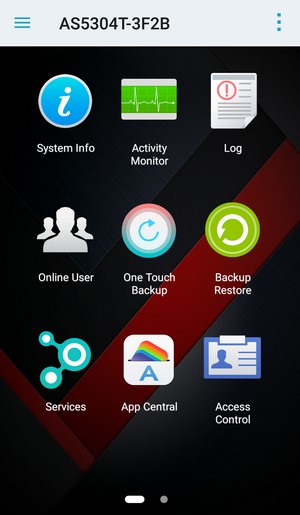







As always ASUSTOR has several applications available for Android and iOS compatible devices including AiMaster which you can use to monitor and access most unit functions and details (you can also install apps from here), AiDownload for HTTP and BitTorrent downloads, AiVideo which allows playback of media stored in the NAS and online/offline transcoding , AiData which allows the user to access files stored in the NAS, AiMusic for audio streaming, AiFoto for picture sharing (you can also create online albums and instantly backup taken pictures from your mobile device to the NAS) and the AiSecure app which grants you access to your IP camera feed (we recommend using auto IP/NAS discovery with each app).
TESTING METHODOLOGY
Originally, we had decided that since some of the NAS servers/devices we've tested in the past are no longer in our possession (naturally) we would keep performing the exact same testing methodology we did in the past for as long as possible in order to provide accurate comparison results. However, since our real-life tests are not enough for some people, we also decided to throw in ATTO V2.47 and Crystal Disk Mark V3.0.4 to cover the more demanding users. However as always we will be using a single Seagate Constellation ES.3 4TB SATA III and up to 10 Seagate IronWolf 12TB SATA III hard disk drives with 3.5” compatible units (we switched to 12TB models for RAID tests since August 2018 – due to high workloads the performance of previous drives had started to deteriorate) and up to two (for now) Enterprise Capacity 2.5 HDD V3 2TB SATA III HDDs with 2.5” compatible units to perform several upload/download tests with 10.9GB (Single) and 40,8GB (RAID) files. Tests are repeated a total of 4 times after which we record the average numbers (from the 4 peak ones) into our charts. The network device used for 1GbE tests is the same Netgear D7800 VDSL Modem/Router we’ve been using lately when performing tests on NAS servers.
* Since June 2015 for 10GbE tests we’ve been using a Netgear ProSafe XS712T 10G Smart Switch and an Intel XT540-AT2 10GbE PCIe card (10GbE compatible NAS cards will be provided from each company and stated in each review).
** In May 2019 we also introduced TB3 (Thunderbolt 3) tests using our latest test rig (X299 AORUS GAMING 9 / INTEL CORE I9 7980XE / 64GB DDR4-3200 / GC-ALPINE RIDGE V2.0). For TB3 tests we'll be using ATTO V4.00.02F, Crystal Disk Mark V6.0.2 and Passmark Performance Test V9.1.
*** As of October 2019, we'll also be using the QNAP QSW-804-4C Ethernet Switch for 2.5/5G NAS reviews. The benchmarking programs used will be ATTO V4.01.0F1, Crystal Disk Mark V6.0.2 and several real-world upload/download tests with 30GB (Single Drive) and 60GB (Raid) files.
TEST RESULTS - 1GBE
SINGLE DISK TESTS
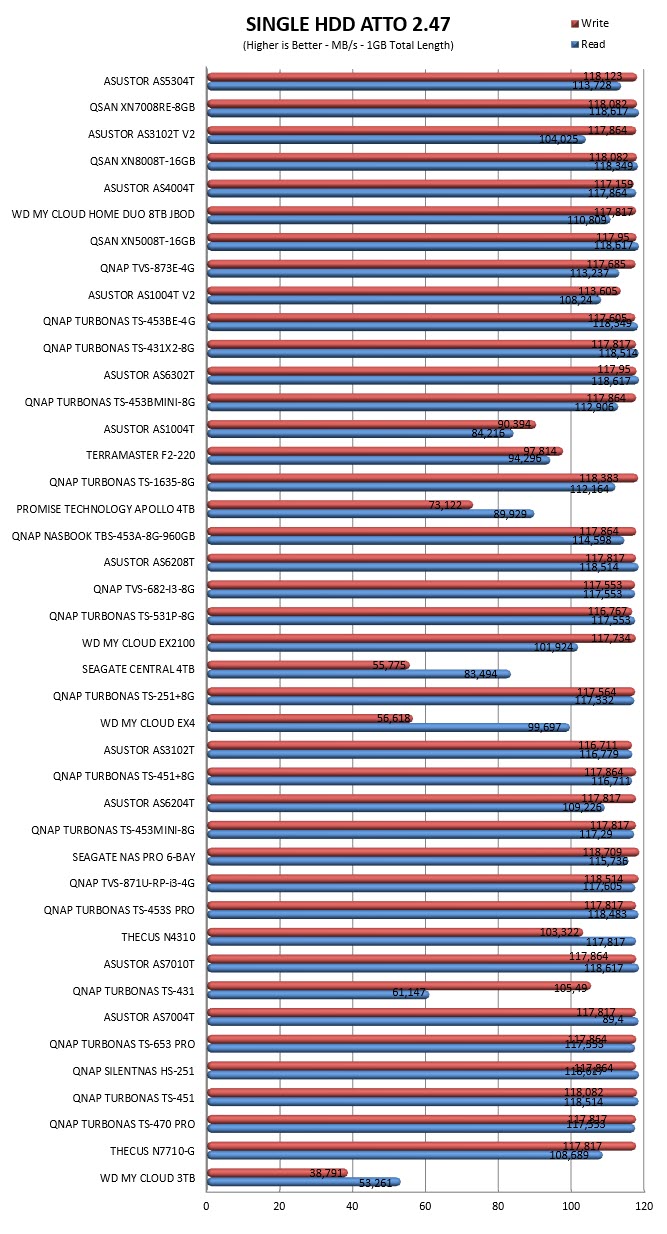


RAID TESTS



TEST RESULTS - 2.5GBE
SINGLE DISK TESTS



RAID TESTS



TEST RESULTS – TEMPERATURES / CONSUMPTION / NOISE


 .............
.............
CONCLUSION
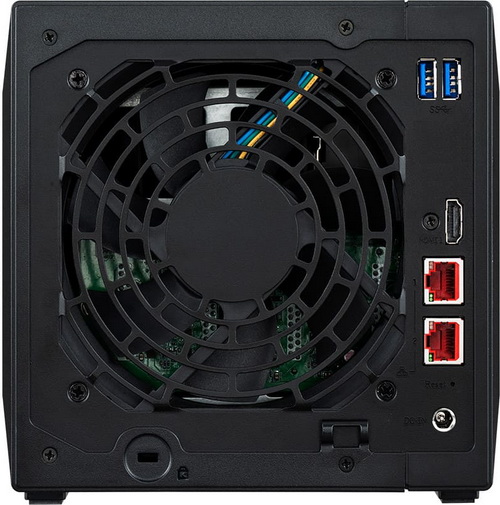
ASUSTOR has once again manufactured a high-performance NAS but unlike every single one of its 1GbE predecessors thanks to the addition of 2.5GbE connectivity (thanks to Realtek) it’s a lot faster, or at least it can be. Unfortunately, just like 10GbE connectivity you need to have the appropriate equipment to effectively use 2.5GbE so both your router/switch and your mainboard need to have such ports. The good news is that mainboard manufacturers have started using Realtek 2.5GbE Ethernet chips in some mainboards and the same goes for some network manufacturers with their latest routers and USB to 2.5GbE adapters. Still we’re talking about a very limited number of such devices (as of now) and the end result doesn’t change much since these models are obviously more expensive (alas not as much as 10GbE compatible models) compared to the “regular” 1GbE models. Moving to noise levels there’s nothing really new here, ASUSTOR claims in their datasheet that the AS5304T doesn’t go over 32dBA during normal use and even though we did record higher numbers keep in mind that we do our tests from just 10-15cm away whereas manufacturers do them from at least 1 meter away. The ADM is as always one of the best operating systems in the NAS industry (287 free apps right of the box) but we do feel that the lack of support for an HDMI media player like KODI (or at least a player with similar features/characteristics) is something that ASUSTOR needs to address, perhaps even more so than QNAP and others since their brand new Nimbustor line is aimed towards gamers. Last but not least the plastic exterior ASUSTOR has been using lately (even though slightly different in design here) may not sit well with some professionals and enthusiasts we’ve talked with recently but for a home-oriented model we don’t think it matter much.
Currently the brand new Nimbustor 4 AS5304T NAS by ASUSTOR retails for USD479 inside the USA (Amazon.com) and for 505Euros inside the EU (Amazon.co.uk) a price tag which is quite balanced for what you’re getting. As mentioned earlier however unless you already have compatible network equipment, you’ll need to spend more in order to fully utilize its 2.5G ports and so this is also something you need to keep in mind. Overall, we’re very satisfied with the Nimbustor 4 AS5304T model, performance if you can use its 2.5G ports is extremely good, power consumption is at low levels and you’re also getting one of the best OS in the market today with support for 287 apps (at the time of this review). Taking into consideration all of the above we’re happy to award the brand new Nimbustor AS5304T with our Golden Award.

PROS
- Performance Levels
- Dual 2.5G RJ45 Ports (Link Aggregation Supported)
- ADM v3 Operating System (287 Available Apps Currently)
- Black & Red Color Theme (For AMD & ASUS ROG Fans)
- Low Power Consumption
- Android / iOS Apps
- Three USB 3.2 Gen 1 Ports
- HDMI v2.0a
- Single / JBOD / RAID 0 / RAID 1 / RAID 5 / RAID 6 / RAID 10 Modes
- Expandable RAM (Up To 8GB DDR4-2400)
CONS
- 2.5G Equipment Costs
- Plastic Enclosure (For Some)

 O-Sense
O-Sense





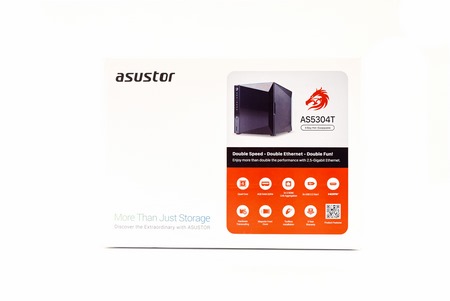












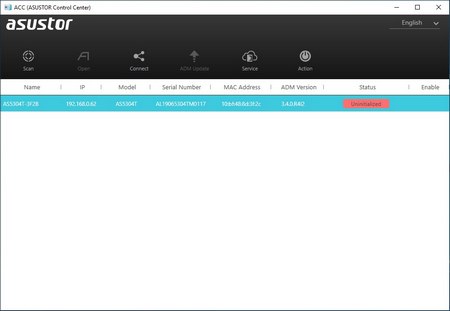





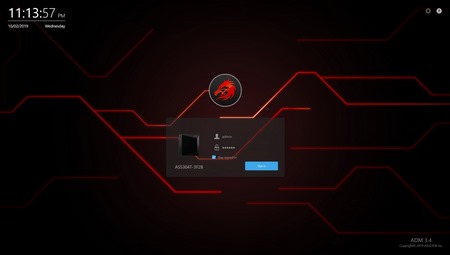














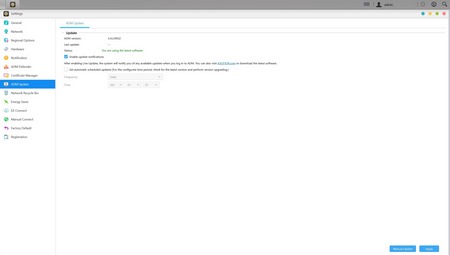








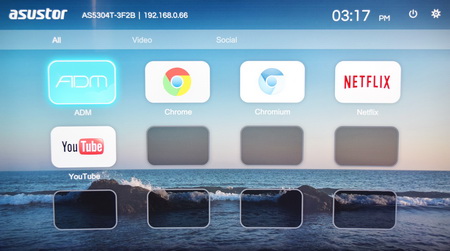







.png)

